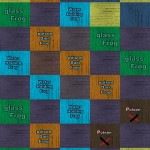Hunger Games
Our young makers have created awesome board games to teach other students about science, such as frog jump that is available on this site.
 You can create a game too and share up a photo and description of it on Makeosity.
You can create a game too and share up a photo and description of it on Makeosity.
Goal: Your task is to design a board or card game that teaches players real facts about frogs, their habitats, predators and prey. If you make a board game, it must include at least 10 trivia questions about frog species and their environments. If you make a card game, it must include at least six frogs, six predators and six adaptations that the frogs can use to survive a predator attack.
Steps:
1) Gather information about the frogs, their habitats, predators and prey that you can use as trivia questions in your game. Write down the facts you identify.
2) Write the rules of the game.
3) List the game elements.
4) Sketch the game board.
5) Sketch the game cards.
6) Write trivia questions.
Vocabulary:
Habitat – a place where animals and plants live and grow. Cities are habitats, so are forests and and deserts. Water forms habitats too. There are freshwater habitats in rivers and lakes and salty water habitats in the sea. Animals and plants are adapted to live in their habitats. A habitat can be enormous, such as a great forest or it can be tiny. Even a small stone forms a habitat for animals living under it.
Predator – an animal that lives by killing and eating other animals.
Prey – an animal that is hunted and killed by another for food.
Adaptation – The adjustment or changes in behavior, physiology, and structure of an organism to become more suited to an environment.
Examples of Frog Adaptations:
Webbed Feet – The longer legs of aquatic frogs, coupled with the extensive webbing between their toes, give these water-lovers a real swimming advantage.
Slimy Skin – Frogs do not swallow water, but absorb it through the skin, and they also absorb much of their oxygen through skin as well. That “slimy” feel humans often associate with frogs is the protective mucus coating. To ensure the skin stays nice and soft, frogs replenish it once a week by pulling the old skin off over their heads like a piece of clothing—revealing fresh new skin beneath.
Periscope Eyes – Because they are large and rounded, they allow the frog to look in all directions without moving his body, making it hard to sneak up on him and giving him a distinct advantage over potential prey. Frog eyes are especially adapted to seeing in dim conditions, which makes these already useful attributes even more important underwater, where conditions are often murky. Another interesting adaptation of a frog’s eyes is their location. Perched on the top of his head, the large eyes act as periscopes for observing predators and prey even as he happily soaks his skin below the water’s surface.
Forty Freaky Frogs:
Freaky Frogs

